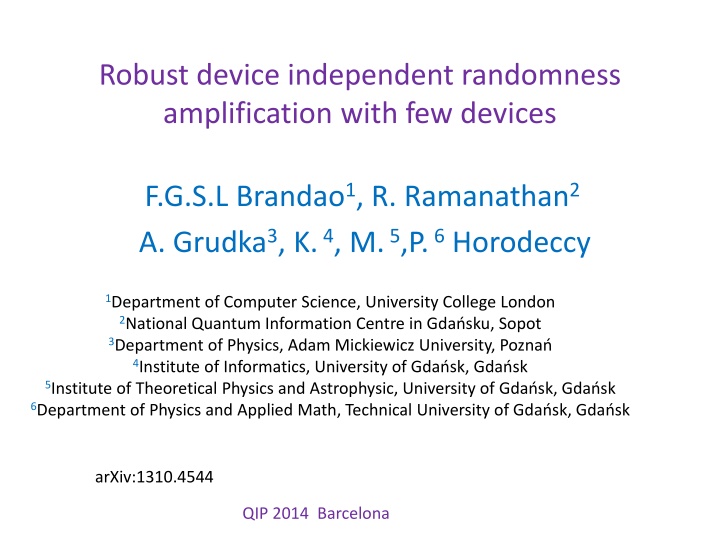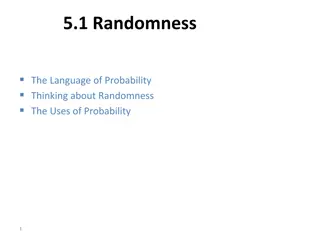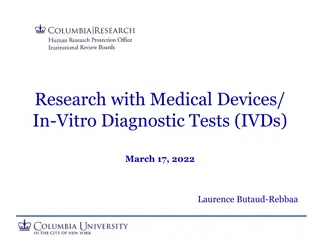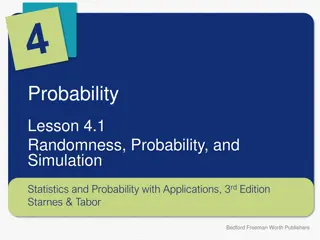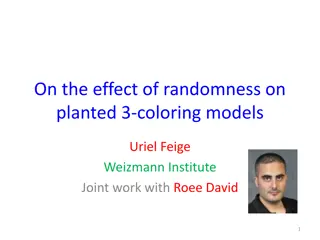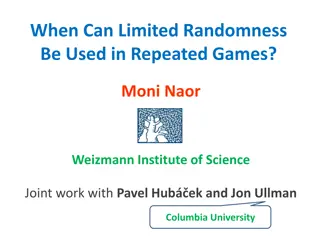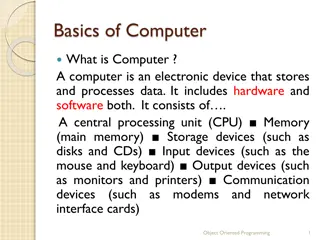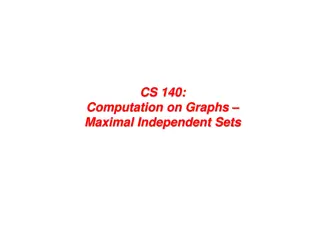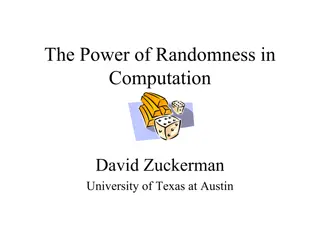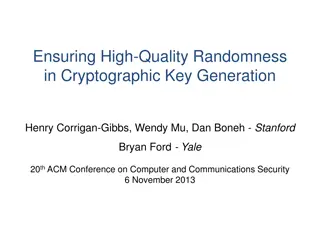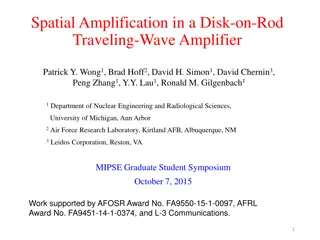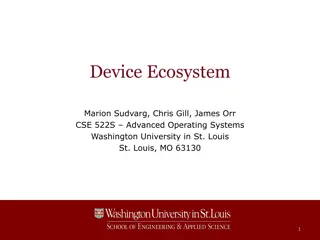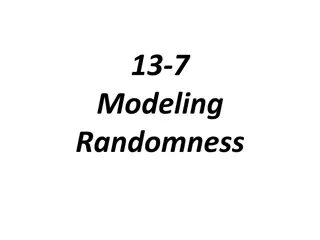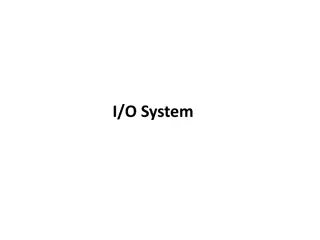Device Independent Randomness Amplification with Few Devices
This study focuses on robust device-independent randomness amplification with limited devices, emphasizing the importance of device independence in generating random outcomes free from external influences. Various sources of randomness, including Santha-Vazirani and Hmin types, and quantum mechanics principles are explored for enhancing randomness generation. The results highlight the potential for quantum mechanics to amplify randomness and the challenges associated with achieving optimal randomness using non-signaling devices.
Download Presentation

Please find below an Image/Link to download the presentation.
The content on the website is provided AS IS for your information and personal use only. It may not be sold, licensed, or shared on other websites without obtaining consent from the author.If you encounter any issues during the download, it is possible that the publisher has removed the file from their server.
You are allowed to download the files provided on this website for personal or commercial use, subject to the condition that they are used lawfully. All files are the property of their respective owners.
The content on the website is provided AS IS for your information and personal use only. It may not be sold, licensed, or shared on other websites without obtaining consent from the author.
E N D
Presentation Transcript
Robust device independent randomness amplification with few devices F.G.S.L Brandao1, R. Ramanathan2 A. Grudka3, K.4, M.5,P.6Horodeccy 1Department of Computer Science, University College London 2National Quantum Information Centre in Gda sku, Sopot 3Department of Physics, Adam Mickiewicz University, Pozna 4Institute of Informatics, University of Gda sk, Gda sk 5Institute of Theoretical Physics and Astrophysic, University of Gda sk, Gda sk 6Department of Physics and Applied Math, Technical University of Gda sk, Gda sk arXiv:1310.4544 QIP 2014 Barcelona
Motivation or ? Does anyone know the result of throwing a coin ? can one decorrelate randomness from the third person: eavesdropper ? Example: make your choice of product to buy independent of your knowledge about commercials
Device independence Danger: Eve can sell device with imprinted bits in advance We do not trust that devices are bulit due to specifiation We only relay on statistics of inputs and outputs of the device Security proof uses only these statistics
Sources of randomness: Santha-Vazirani and Hmin type Definition: A sequence X1 . Xn satisfies condition of Santha-Vazirani if for any i there is: 1 2 ? ? ??= ??? 1 2+ ? e any variable that could have influenced the variable Xi Fact: classics => no go [M. Santha, U.V. Vazirani 1984] Classical processing of SV source does not lead to randomness amplfication A sequence X1 . Xn is linear ????source if ???? (X1 . Xn ) > cn for some c >0 Weaker source of randomness: Fact: Non explicit extractor From 2 independent min-entropy sources => fully random bit From 3 independent min-entropy sources => fully random bit Explicit extractor [Chor and Goldreich 88, Rao]
Quantum mechanics allows for randomness amplification [R. Colbeck & R. Renner, Nature Physics 2012] Some measurements on maximally enatangled states are random Idea: results of these measurements violate certain Bell inequality N-th chained Bell inequality Result : For optimal 0.0961 [A.Grudka et al. arXiv:1303.5591] [Gallego et al. arXiv:1210.6514 ] 1 2 For any Use of 5-partite Mermin inequality 0< ? < There exists hash function which outputs perfect bit Drawbacks: - hash function is not explicit - asymptotically many non-signaling devices - tolerance of noise not included [R. Ramanathan et al. arXiv:1308.4635]
The results 1 2 0< ? < Starting from any epsilon-Santha-Vazirani source: obtain bits of randomness secure with respect to non-signaling Eve 1) Protocol (I) of randomness amplification with: - single device, but non-explicit function - tolerance of noise Main tool: proper use of implicit assumptions 2) Protocol (II) of randomness amplification with: - - - 2 devices explicit hash function tolerance of noise Main tool: SV-version of deFinetti theorem
The scheme of randomness amplifier SV source 101011000101110101 in source SV Eve P(XZ|U,W) Device: Alice Bob A device Extractor Extractor out S randomness of alfabet size | | Task: 0 out < in Quality of randomness: small
The protocol I Single Device The protocol : 1) Use Device 1 n times taking as inputs bits from SV source 2) Check the level of Bell violation after n runs 4) Upon good level of Bell violation in 2), apply Extractor to device and SV source
Assumptions (I) Assumption1: (fixed device) the device does not depend on SV source ?? ?(?|?) Assumption 1 : (Markovity) : given output of Eve, the device and SV source are product: ?? ?(?|?? = ?,? = ?) Cf. [Colbeck and Renner 2012] [Gallego et al. 2012] Note: these assumptions are independent
Assumptions (II) Assumption2: (conditional non-signaling) Conditionally on these results these blocks do not signal Note: it is reasonable, as quantum devices satisfies it
Idea of the proof for protocol I ???? By assumption I: SV source serves itself as source independent of the output of the devices Note: we do not impose independence of the sources, as that would be trivial u time SV source 10100101010111000111010101010 Reason for independence: u decorrelates two sources y Devices: P(x|u) P(x|y,u) = P(x|u) x ???? Two independent sources => non-explicit extractor yields secure bit Note: we have to verify if device violates Bell inequality. If it does not, there is no way to check if the device is not deterministic function to which a SV no-go applies.
Protocol II Device 2 Device 1 Block 1 Block 2 Preliminary assumptions: Devices: - Do not signal between each other - Are forward signaling (past can influence the future) The protocol : 1) Use Device 1 n times taking as inputs bits from SV source forming the block 1 2) Out of n x N2 uses of Device 2 choose the block 2 of n uses, by means of SV source 3) Check the level of Bell violation in both blocks 4) Upon good level of Bell violation in 3), apply Extractor to these two blocks and SV source Security claim: protocol I, upon acceptance provides secure bit up to error that vanises with uses of devices with high probability
Idea of the proof for protocol II ???? 1) By assumption I: SV source serves itself as source independent of the output of the devices 2) By assumption II + new type of deFinetti theorem: The two blocks of uses of devices (#1 and #2) are product with each other time SV source 10101010111000110101010111000000110 Block 2 Block 1 3 independent sources: good for 3-extractor ???? [Chore,Goldreich 88] Secure bits (SECRECY AGAINST NO-SIGNALING ADVERSARY )
Ingredients of the proof (i) a Bell inequality Q NS P* Entangled 4-qubit in state | u=0 - measure z , u=1 - measure x u1, x2 , x A2 LHV u1 u2 u3 u4 u2,x2 Violated up to NS value B.P=0 A1 {P(x|u)} A3 u4,x4 x1 x2 x3 x4 A4 u3,x3 Lemma.- Suppose B.{P(x|u)}= >0then for any measurement setting u and output x, there is: Pr(x|u) [1 + |?|(1 2 ?)4]/3. ? < 1 Interpretation: output of a box is partially random, even when noise is allowed Proof: by Linear Programming (analytical solution) [Hanggi Renner EUROCRYPT 2010]
Ingredients of the proof (ii) Azuma-Hoeffding inequality for estimation Adaptation of [Pironio et al. 2010,2013 Fahr et al., Pironio Massar, 2013] for randomness expansion Azuma-Hoeffding inequality enables estimation With high probability: There are at least g x n of good boxes (with Bell value at most ) with g > 0 Hence for any u,x: ??? ? ? . 1 ???? ~ ~ log Linear in n ???
Ingredients of the proof (iii) de Finetti theorem [Brandao Harrow STOC 13] + SV correction
Ingredients of the proof (iii) de Finetti theorem Device 2 Device 1 Uses prior to Block 2 Block 1 Recall: number of Block 2 is chosen according to bits from SV source Block 2 Average over the choice of from SV source , and output , Outputs are close to product
Putting the pieces together: We choose a Bell inequality, which is algebraically violated on quantum state The protocol : 1) Use device #1, N times 2) Out of NxK uses of device #2 choose a block of N uses, by means of SV source 3) Check the level of Bell violation in both the blocks 4) Upon good level of Bell violation in 3), apply Extractor to these two blocks By DeFinetti Block 1 and Block 2 are almost product By Azuma-Hoeffding: enough good boxes for linear Hmin By assumptions, and the above, there are 3 Hmin sources close to product: The rest of SV source and two blocks => Extractors work!
Conclusions and Open problems Full randomness amplification w.r.t. to non-signaling adversary using small number of devices ( 1 or 2) is possible. Noise tolarance dependence show. Drawback 1 of our protocol: to make deFinetti work we need to make t large: Large number of uses extractor ? Drawback 2: for single device nonzero rate but no explicit extractor, for two devices explicit extractor but zero rate due to error Can we obtain a protocol with non-zero rate of amplified randomness and explicit | | exp(-cn ?) (in preparation) Can one achieve randomness amplification for any epsilon, from bipartite devices ? Tolerance of noise is there a protocol which is more robust against noise ? ???? Could we start not from SV-source, but from the one ? Finally : proof applies for 2 devices and 3 devices respectively if we don t use the SV apart from setting the inputs.
